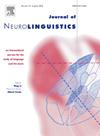Semantic and syntactic language differences associated with the FMR1 premutation genotype
IF 1.2
3区 心理学
Q2 LINGUISTICS
引用次数: 0
Abstract
The FMR1 premutation genotype occurs in approximately 1 in 150 women and 1 in 470 men. New evidence suggests that the FMR1 premutation may be associated with language differences, although the breadth of language challenges, specific domains affected, and potential interface with executive aspects of the phenotype are not fully understood given the lack of targeted studies. The present study compared the language skills of 109 women with the FMR1 premutation to 109 age-, education-, and nonverbal IQ-matched control women, using a series of standardized language repetition tasks to index language abilities within a measurement context that reduces the influence of higher-order executive deficits. Results indicated that, relative to controls, women with the FMR1 premutation performed significantly worse on tasks assessing semantic and syntactic, but not phonological, skills. Group differences could not be accounted for by attention or working memory difficulties. This study documents semantic and syntactic language differences associated with the FMR1 premutation genotype. Findings may have implications for identifying gene-brain-behavior mechanistic pathways, with more research needed to characterize the clinical impact of language differences associated with this genotype. FMR1 may play a role in mediating some aspects of language in the population.
语义和句法语言差异与FMR1突变前基因型相关
FMR1预突变基因型在150名女性和470名男性中分别约有1人和1人。新的证据表明,FMR1预突变可能与语言差异有关,尽管由于缺乏针对性的研究,语言挑战的广度、受影响的特定领域以及与表型执行方面的潜在接口尚未完全了解。本研究将109名FMR1基因突变女性的语言技能与109名年龄、教育程度和非语言智商匹配的对照组女性进行了比较,使用一系列标准化的语言重复任务,在减少高阶执行缺陷影响的测量环境中对语言能力进行索引。结果表明,与对照组相比,FMR1基因突变的女性在评估语义和句法技能(而不是语音技能)方面的表现明显更差。群体差异不能用注意力或工作记忆困难来解释。本研究记录了语义和句法语言差异与FMR1预突变基因型相关。研究结果可能对识别基因-脑-行为机制通路有影响,需要更多的研究来表征与该基因型相关的语言差异的临床影响。FMR1可能在调节人群语言的某些方面发挥作用。
本文章由计算机程序翻译,如有差异,请以英文原文为准。
求助全文
约1分钟内获得全文
求助全文
来源期刊

Journal of Neurolinguistics
医学-神经科学
CiteScore
3.90
自引率
5.00%
发文量
49
审稿时长
17.2 weeks
期刊介绍:
The Journal of Neurolinguistics is an international forum for the integration of the neurosciences and language sciences. JNL provides for rapid publication of novel, peer-reviewed research into the interaction between language, communication and brain processes. The focus is on rigorous studies of an empirical or theoretical nature and which make an original contribution to our knowledge about the involvement of the nervous system in communication and its breakdowns. Contributions from neurology, communication disorders, linguistics, neuropsychology and cognitive science in general are welcome. Published articles will typically address issues relating some aspect of language or speech function to its neurological substrates with clear theoretical import. Interdisciplinary work on any aspect of the biological foundations of language and its disorders resulting from brain damage is encouraged. Studies of normal subjects, with clear reference to brain functions, are appropriate. Group-studies on well defined samples and case studies with well documented lesion or nervous system dysfunction are acceptable. The journal is open to empirical reports and review articles. Special issues on aspects of the relation between language and the structure and function of the nervous system are also welcome.
 求助内容:
求助内容: 应助结果提醒方式:
应助结果提醒方式:


